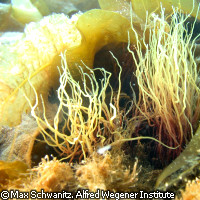Sunburnt seaweed? Yes, it's true
Humans aren't the only victims of sunburn; algae also get burnt. Alfred Wegener Institute researchers have investigated the reaction of seaweeds to increased ultraviolet radiation and found that they react sensitively when hit with a bigger dose. Despite a plant's capacity to photosynthesise, the process of a metabolic pathway that converts light energy into chemical energy, too much sun may result in too much energy thereby effectively killing the algae's sensitive pigments. The marine plants then become ill, spotty, pale and rotten. So how do algae protect themselves from the sun's blistering rays? The experts say that unlike humans, who have access to sunscreen and clothing accessories, plants must build their own protection strategies. 'A species of red algae, for instance, produces under increased ultraviolet radiation less red light-harvesting proteins, thus decreasing the absorption of radiation,' said Professor Christian Wiencke from the Alfred Wegener Institute (AWI) for Polar and Marine Research, one of 15 research centres within the Helmholtz Association. 'The typical red colour of the algae fades and the plant gets white tips. The algae additionally produce substances which react similar to melanin in human skins: mycosporin amino acids (MAA).' By absorbing energy, melanins protect microorganisms against stresses that involve cell damage by solar ultraviolet radiation. Because of the depletion of the ozone layer, which normally absorbs most of the damaging solar ultraviolet radiation (of short wavelength), the sun's rays penetrate seawater more easily, the research team said. The scientists, stationed at the French German Research Base AWIPEV on Spitsbergen, a Norwegian island near Greenland, investigated this issue through a number of extensive experiments. 'We examine the harmful effects of ultraviolet radiation on algae and their protective mechanisms,' explained Professor Wiencke. The group found that ultraviolet radiation damages the algae's photosynthesis and their hereditary material. The result is a decline in both the growth rate of the organisms and the rate of reproductive success. The team said that tiny ultraviolet doses are enough to damage and inhibit the germination of spores and germ cells. 'Our investigations show that the distribution of certain species of brown algae is inhibited by the climate of ultraviolet radiation,' said Professor Wiencke. 'The algae are displaced into deeper water layers if ultraviolet radiation increases.' The AWI researcher noted that the conditions at the Spitsbergen site were optimal for this project. He said that he and the team wanted to 'observe the development of marine coastal ecosystems in the face of global climate change'. Professor Wiencke commented: 'Not only does increased ultraviolet radiation play a decisive role, but (so does) the water temperature which has been increased by the greenhouse effect. This increase in temperature can particularly be felt on Spitsbergen, in the Atlantic sector of the Arctic.'
Countries
Germany, Norway



